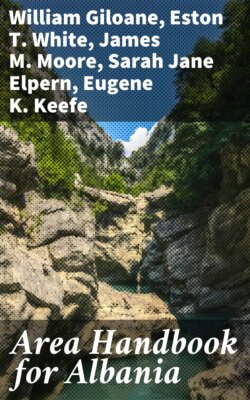Читать книгу Area Handbook for Albania - Stephen Peters - Страница 5
На сайте Литреса книга снята с продажи.
COUNTRY SUMMARY
ОглавлениеTable of Contents
1. COUNTRY: People's Republic of Albania (Albania). Called Shqiperia by Albanians. A national state since 1912. Under Communist control after 1944.
2. GOVERNMENT: Functions much like Party-state model of Soviet Union. Constitution designates People's Assembly as highest state organ; its Presidium conducts state affairs between Assembly sessions. People's Council highest organ at district and lower echelons. Communist Party (officially, the Albanian Workers' Party) organizations parallel government organizations and control them from national to local levels. Party members hold all key positions in government.
3. SIZE AND LOCATION: Area, 11,100 square miles; smallest of the European Communist states. Extends 210 miles from southern to northern extremities; 90 miles on longest east-west axis. Bordered on north and east by Yugoslavia; on southeast and south by Greece; and on west by Adriatic and Ionian seas.
4. TOPOGRAPHY: A narrow strip of lowland borders Adriatic Sea; remainder of country is mountainous and hilly, intersected by streams that flow in westerly or northwesterly direction. Terrain is generally rugged.
5. CLIMATE: Unusually varied. Coastal lowlands have Mediterranean-type climate. Inland fluctuations common, but continental influences predominate. Annual precipitation is 40 to 100 inches according to area; highly seasonal; summer droughts common. Temperatures vary widely because of differences in elevation and the changes in prevailing Mediterranean and continental air currents.
6. ADMINISTRATIVE DIVISIONS: Twenty-six districts. Economic and social factors played important role in shaping delineations. Control and direction is from Tirana.
7. POPULATION: Estimated 2.1 million in January 1970. Growth unusually rapid; at 1970 rate, would double in twenty-six years. Two-thirds live in rural areas. Inhabitants are 97-percent ethnic Albanian. About 106 males per 100 females.
8. LABOR: In 1967 the working-age population numbered about 932,000, of which approximately 745,000 were employed. About 66.7 percent were in agriculture; 14.1 percent in industry; 5.4 percent in construction; and 13.8 percent in trade, education, health, and others.
9. LANGUAGE: Albanian spoken by everyone. Some of the 3-percent minority use tongue of country of family origin as a second language.
10. EDUCATION: Nearly all persons under age forty are literate, according to Albanian statistics. Communist ideas and principles emphasized with strict controls by centralized authority. Production of capabilities and skills required for modernization and industrialization considered to be a major goal.
11. RELIGION: Organized religion destroyed by government action in 1967. Party-directed antireligious campaign aims to eliminate religious thought and belief. Pre-World War II data indicated population to be 70-percent Muslim, 20-percent Eastern Orthodox, and 10-percent Roman Catholic.
12. HEALTH: Many diseases, but reportedly greatly reduced or eliminated. Health improved substantially after 1950, as reflected in Albanian reports. Malnutrition, poor sanitary-hygienic conditions, and lack of trained personnel are continuing problems.
13. JUSTICE: System of people's courts from national to village level; purportedly independent of administrative system but guided by Party policy. Supreme Court elected by the People's Assembly. District judges popularly elected from among Party-approved candidates. Jury system not used. Persons are subject to military law and tried in military courts.
14. ECONOMY: Government controlled. Follows planning model of Soviet Union. Per capita gross national product lowest in Europe. Lack of accessible resources, arable land, and trained work force make for slow growth.
15. INDUSTRY: Poorly developed despite heavy emphasis since 1950s, with priority to means of production. Extractive industries most productive. Growth rates high in 1950s, slowed in 1960s.
16. AGRICULTURE: Production low because of lack of arable land and inefficient methods. Cereal crops for domestic use and exportable items, such as tobacco, fruits, and vegetables, most important.
17. IMPORTS: Largely items for industrial development and unfinished materials for processing. Some food, but quantity decreasing.
18. EXPORTS: Mostly at the expense of domestic needs, except for some metals and minerals. Low in proportion to imports, but increasing.
19. FINANCE: Currency: The lek is standard unit; lacks solid backing. Banks are state owned and operated. National income consistently less than expenditures, requiring supplement from foreign sources.
20. COMMUNICATIONS: Government owned and controlled. Press and radio as instruments to indoctrinate effectively reach the masses. Other media poorly developed.
21. RAILROADS: Approximately 135 miles standard-gauge. None cross international borders.
22. ROADS: Approximately 3,000 miles have improved surface. Rugged terrain makes travel difficult on others. None part of important international routes.
23. PORTS: Durres, largest and most important, alone links with hinterland. Vlore only other major port.
24. AIR TRANSPORTATION: Extremely limited within country and with foreign cities. Long-distance international flights require connections through intermediate points. Facilities for all but small aircraft limited to Tirana area.
25. INTERNATIONAL AGREEMENTS AND TREATIES: Member, United Nations after 1955. Member, Council for Mutual Economic Assistance (COMECON) and Warsaw Treaty Organization, 1955-68; participation all but ceased after 1961 split with Soviet Union.
26. AID PROGRAMS: United Nations Relief and Rehabilitation Agency (UNRRA) 1945-46; Yugoslavia 1947-48, as an integrated economy; Soviet Union 1948-61; and Communist China after 1961.
27. SECURITY: Party-controlled agencies closely watch people's activities and secure borders. Security forces total approximately 12,500.
28. ARMED FORCES: The People's Army, approximately 40,000, includes army, navy, and air elements. Most conscripts serve two years. Cost, about 10 percent of total budget.
